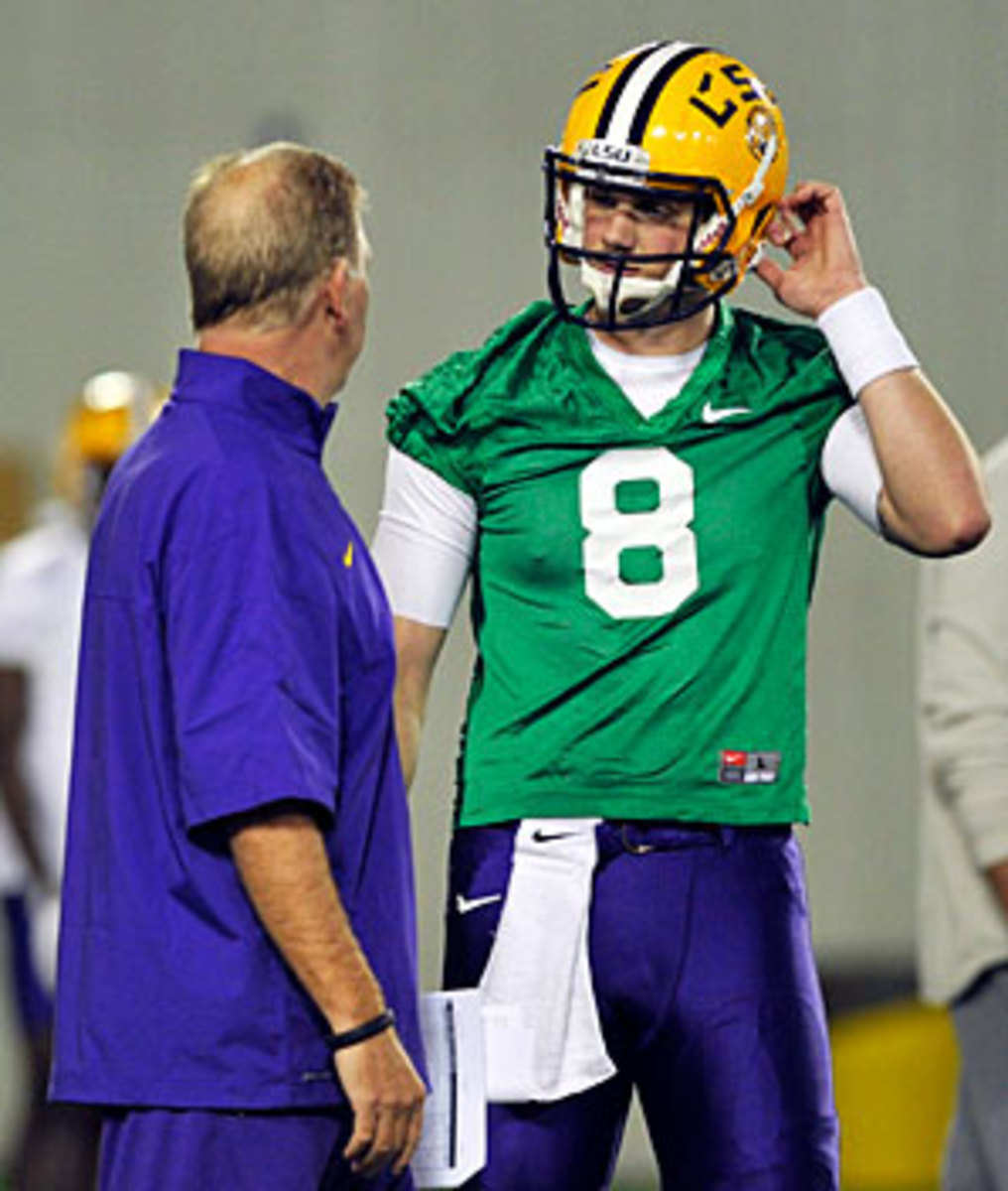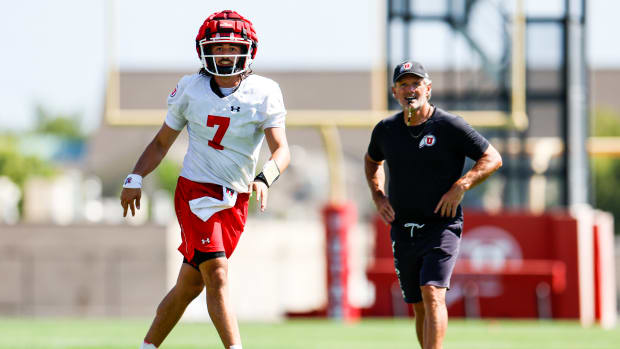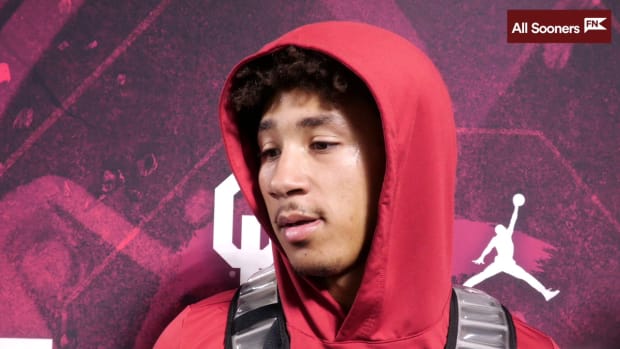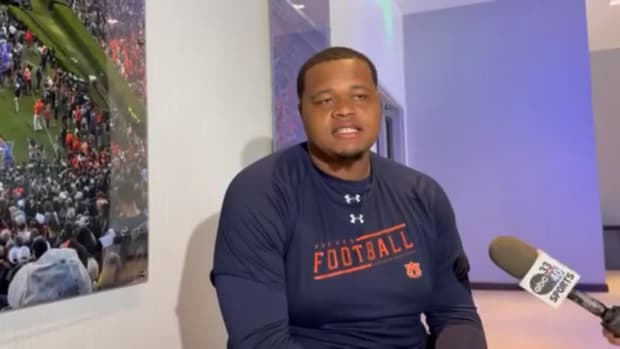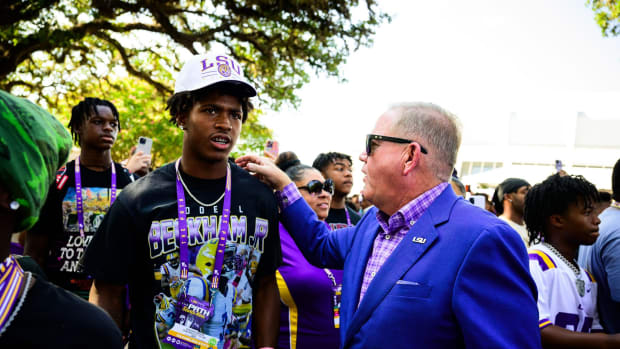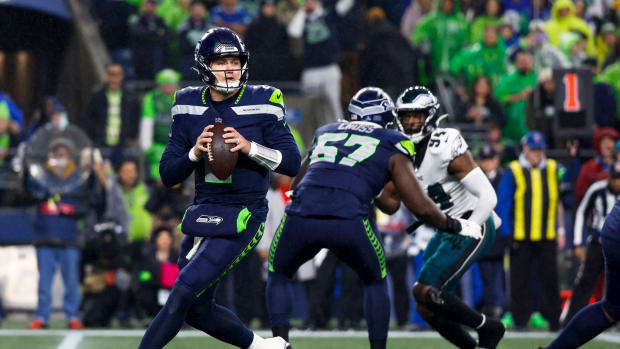Cameron shaping LSU offense with lessons from unlikely sources
BATON ROUGE, La. -- The Associated Press story filed on Sept. 20, 1975 with the CARBONDALE, Ill., dateline explained the who, what, when, why and where. But it left out the truly magical moment. Dave Vandercook, a freshman kicker at Indiana State, lined up for a 55-yard field goal with a few seconds remaining and Southern Illinois leading by one. Vandercook missed. But Southern Illinois got flagged for jumping offsides. So Vandercook lined up again for a 50-yarder. He made it.
The 177 words of this dispatch the Chicago Tribune chose to run the next day explained the basics of the Sycamores' 23-21 win, including the fact that Vandercook's final kick cleared the crossbar by three feet. They did not, however, mention the Indiana State ball boy who caught Vandercook's game-winning field goal. That's where the story gets really interesting.
Beneath the goal posts that day in Carbondale was a high school freshman whose mother had recently married Indiana State coach Tom Harp. The kid was a pretty fair athlete himself, so good at quarterback that when he became a sophomore his coach at South Vigo High in Terre Haute, Ind., allowed him to call the plays himself. His name? Cam Cameron. Since that moment -- whether playing football for Lee Corso, playing hoops for Bobby Knight, coaching at Michigan and Indiana, becoming an uber-successful NFL offensive coordinator or getting fired in the midst of a Super Bowl run -- Cameron has spent nearly every moment chasing the high that surged through his body when he caught that ball and saw the Sycamores charge off their sideline to dogpile the freshman who had kicked it.
"I've never looked back," Cameron said this week. "And I've never worked a day in my life."
Cameron has gone to an office and drawn a paycheck, but he has never considered football work. To him, every game is one more opportunity to recreate what he felt that day in Carbondale. Cameron's newest opportunities will come at Tiger Stadium. After Baltimore Ravens coach John Harbaugh fired Cameron in December in what he called "the hardest thing I've had to do as a coach," Cameron had a few options. Several NFL teams called. But so did old friend Les Miles, with whom Cameron shared an office when the men were assistants together under Bo Schembechler at Michigan. LSU offered a three-year, $3.4 million contract, which made the Tigers competitive with any NFL team. So Cameron, who hadn't coached in college since he was fired as alma mater Indiana's head coach in 2001, went back to campus with the goal of creating an LSU offense worthy of sharing the same sideline with the Tigers' vaunted defense.
To do this, Cameron will teach his players lessons collected from some unlikely sources. When he was a sophomore in high school, Cameron met a man who would help shape his play-calling philosophy. His name was Larry Bird.
Yes, that Larry Bird.
Bird had just enrolled at Indiana State following a 24-day stint at Indiana and a year off to collect himself. In the offseason, the Sycamores basketball team played pickup games in the gym. The football coach's kid would bring his high school teammates, and they would join the college players. Often, Cameron found himself on the same team as one of the greatest basketball players of all time. "If I was more open than him, he would pass it to me," Cameron said. "But he expected me to make the shot."
At first, Cameron didn't understand why the best player on the floor by a mile would pass to a high-schooler. Then he realized Bird did this to earn the trust of his teammates. When Cameron began calling plays for South Vigo's football team, he followed Bird's lead and tried to get the ball to as many of his teammates as possible. Cameron can still tick off the names of the backs and receivers who became his best friends. "All you had to do was keep them involved, and they'd run through a wall for you," Cameron said. "Football is hard. Guys don't selfishly want the ball. But they want some reward for all their hard work."
Harp watched Cameron call the plays with pride -- not that he let his son know that at the time. "He had the confidence of the team, and he called them," Harp said. "I was very impressed with how sharp he was. Now, we argued all the time. I never wanted to give him the satisfaction that he'd done a great job -- even though he did."
Cameron got most of the ink as the best quarterback in Indiana at the time, but he disagreed. He thought the quarterback at Reitz Memorial in Evansville was better. That guy's name was Don Mattingly.
Yes, that Don Mattingly.
A 1989 Sports Illustrated story by Peter Gammons explained that Mattingly is truly ambidextrous -- that as a youngster he would pitch a few innings left-handed and then a few innings right-handed to stay fresh. But Cameron said Mattingly could also throw a football equally well with either hand. "He would have been Steve Young playing football," Cameron said. "He was that good."
Watching Mattingly taught Cameron to look for unique attributes in a quarterback. That philosophy has helped him bring out the best in a diverse group of signal-callers. He trained Elvis Grbac at Michigan, Antwaan Randle El at Indiana, Drew Brees and Philip Rivers in San Diego and Joe Flacco in Baltimore. He found a way to maximize each one. Still, when Cameron thinks of Mattingly, he wonders what he could do with an ambidextrous quarterback. So any high school quarterbacks who can chuck it lefty and righty may want to send some film to Baton Rouge.
Of course, one of Cameron's most innovative lessons came from a quarterback who had no choice but to throw left-handed. His name was Jim Abbott.
Yes, that Jim Abbott.
At one point in Cameron's Michigan tenure, quarterbacks Grbac and Todd Collins had issues with the quarterback-center exchange at practice. At the time, Abbott -- who was born without a right hand -- had already pitched for Michigan and the U.S. Olympic team and was an established major league pitcher for the Angels. But Cameron remembered that Abbott had played quarterback for Flint (Mich.) Central High. So he contacted the coach and requested film of one of Abbott's football games. "Playing one-handed, they had no center-quarterback exchange issues," Cameron said. "So I showed it to those guys to make the point that you don't need two hands to take the snap from center."
Cameron said that at some point before LSU concludes spring practice on Saturday, he'll show the Tigers' quarterbacks a YouTube clip of Abbott fielding ground balls as a pitcher and then tell them the story of Abbott the football player. The point? Sometimes, because of the defense or because of conditions beyond their control, players don't have all their tools available to them. That doesn't mean they can't get more out of what they do have.
Cameron likes what he has at LSU. He said incumbent starting quarterback Zach Mettenberger is adjusting well to the offense, and the coach who devised a myriad of ways to get LaDainian Tomlinson the ball in San Diego relishes the prospect of finding open space for backs Jeremy Hill and Alfred Blue. "Good backs like this," Cameron said, "test your imagination."
Many of the stories from LSU's spring practice have suggested a drastic shift in offensive philosophy to a tempo more similar to the one preferred in the Big 12. LSU will play faster, Cameron said, but the Tigers probably won't be confused for Chip Kelly-era Oregon. The biggest difference to the naked eye likely will be the way Cameron deploys LSU's backs -- who will get moved around the field to create mismatches. "We want to have the winningest offense in college football," Cameron said. "Not the No. 1 offense in college football statistically."
Miles still will have heavy input into the offense. So will offensive line coach Greg Studrawa, who served as LSU's offensive coordinator the past two seasons. The original plan in 2011 was for Steve Kragthorpe to take over for Gary Crowton, but when Kragthorpe was diagnosed with Parkinson's disease that August, Studrawa was pressed into coordinator duty. After two seasons of less-than-dynamic offense, Miles decided to make the change.
His old friend Cameron was available because the Ravens had fired him 13 games into a season in which they eventually won the Super Bowl. Cameron has never badmouthed Harbaugh's decision. Quite the contrary. In January, he told the New York Times the firing was a "brilliant" motivational ploy. Harbaugh, who had wrestled with the decision, ordered Cameron a Super Bowl ring. Hart once again marveled at his son's poise. He praised the way Cameron handled the adversity, noting that he probably wouldn't have handled the situation nearly as well. "I told him I'm not as compassionate as he is," Hart said. But, Hart said, Cameron has always been an eternal optimist. "When he was a kid, if he came across a pile of horse manure, he'd start digging looking for a pony," Hart cracked.
Cameron sees only sunshine in Baton Rouge, and with good reason. While early departures took a huge chunk out of LSU's defense, the offense didn't suffer as badly. As defensive coordinator John Chavis helps his young crop of swamp monsters adjust to the SEC, a more productive offense is exactly what the Tigers need. Cameron thinks his offense has the raw material to provide that production. All he and his assistants have to do is coach them properly. "If you do all the little things right, and then you get players that are talented," Cameron said, "they'll take care of the big things." The players are talented. And if they can take care of enough big things, maybe Cameron can replicate that rush he felt that day in Carbondale a few more times.
Photo gallery: LSU's Jeremy Hill among SEC players to watch in 2013
